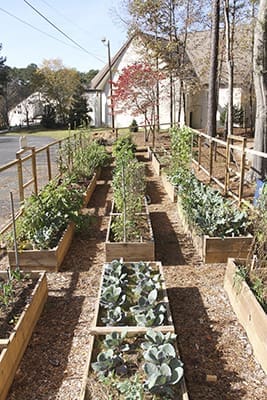 Photo by Michael Alexander
Photo by Michael AlexanderTyrone
Grant to help parishes, schools spend less on energy, more on ministry
By ANDREW NELSON, Staff Writer | Published March 23, 2017 | En Español
TYRONE—Gary Gabriel was puzzled as he stood among the wood trusses holding up the roof. Where was the barrier detailed on the building blueprints to keep hot air out of the attic?
Gabriel, an energy consultant, shone his flashlight on pink insulation on the ceiling tiles. He thought aloud how this variance from the building plans could play a part in the steep electrical bills at St. Matthew Church, Tyrone. The hot air infiltrates the building without a barrier, which helps to keep the air conditioner running.
“The lack of an air barrier is a bummer. Make lemonade, do the best with what you’ve got,” he said of the newly discovered gap.
Spray-in insulation may help the situation, he said.
As part of an energy audit, Gabriel and the St. Matthew parish staff recently spent more than 90 minutes poring over the building’s blueprints, climbing into the attic and inspecting an air conditioner and furnace the size of a train boxcar.
“Doing sustainable design is looking at everything,” Gabriel said.
St. Matthew is the first of nine parishes and three Catholic schools to undergo an audit through this new program. A $25,000 private grant is helping the parishes and schools to be better environmental stewards. Savings identified by the energy audits can be better spent on ministries, not the light bill.
Susana Ikhwan, director of St. Matthew parish operations, said the church community has a goal to be environmentally aware. A recycling program for plastic and metal cans is part of parish life. An organic garden on parish grounds provides fruits and vegetables to church members and to a local food pantry.
“We try to be conscientious,” she said.
The audit’s first task was to look at the cost of utilities and related expenses. Compared to other houses of worship on an industry benchmark of energy consumption, Gabriel said the parish building had a poor showing. Electrical usage was high for the size of the 17-year-old structure.
“We know there’s room for improvement. It’s an opportunity. Where is all the energy going?” he said.
Pope’s vision inspired archdiocesan action plan
The audits are the most recent step in the archdiocese responding to Pope Francis’ 2015 encyclical “Laudato Si’: On Care for Our Common Home.”

A two-year-old community vegetable garden at St. Pius X Church, Conyers, provides fresh produce for people served by the parish St. Vincent de Paul Society food pantry. A garden like this is one of the ideas in the environmental action plan developed by the Archdiocese of Atlanta. Photo by Michael Alexander
The document linked environmental degradation and global warming with the moral imperative to care for creation that is a tenet of Catholic social teaching. The pope issued a call for “swift and unified global action” to stop destruction of the environment and initiate more responsible remedies to preserve clean air, clean water and other essentials of a habitable world.
“The climate is a common good, belonging to all and meant for all. At the global level, it is a complex system linked to many of the essential conditions for human life,” he wrote.
“The universe unfolds in God, who fills it completely. Hence, there is a mystical meaning to be found in a leaf, in a mountain trail, in a dewdrop, in a poor person’s face. The ideal is not only to pass from the exterior to the interior to discover the action of God in the soul, but also to discover God in all things. St. Bonaventure teaches us that ‘contemplation deepens the more we feel the working of God’s grace within our hearts, and the better we learn to encounter God in creatures outside ourselves,’” he wrote.
In response to the encyclical, the Atlanta Archdiocese worked with scientists affiliated with the University of Georgia to develop practical recommendations so Catholics can adopt environmentally sound practices in small and large projects.
The energy checks cover two aspects of the action plan, water and energy conservation.
Susan Varlamoff, former director of the Office of Environmental Sciences at UGA, spearheaded writing the document. Recently retired from the university, she is the author of two books about environmental sustainability. She leads the creation care team at her parish, St. John Neumann, Lilburn.
With support of its ministries, the parish cut waste by 50 percent. Varlamoff said the parish bought plates and cutlery to wash and reuse, instead of throwaway plates.
The Archdiocese of Atlanta action plan is being considered by other dioceses in the Northeast, Varlamoff said, and has been adopted by the Archdiocese of New Orleans. People are interested because it links the vision of the pope with practical steps for parishes and individuals, she said.
“It gives parishes the ways they can become green,” she said.
Grant pays for sustainability audits
The energy audit is a collaboration of individuals and faith organizations. Rutherford and Laura Seydel, who have a long history of environmental philanthropy, provided the seed money for the Atlanta Archdiocese project. The audits are being managed by Georgia Interfaith Power and Light, a faith-based environmental nonprofit. Also participating in the project are the Southface Energy Institute and the U.S. Green Building Council.
The goal is for the audited parish and school complexes to cut their carbon footprint by 30 percent and to increase conservation efficacy by at least 25 percent. The audits are scheduled to be complete by September.
Varlamoff said parish leaders are eager to participate. Pastors and business managers are always looking for ways to reduce parish costs, she said. They know if they can reduce expenses for electricity, the savings can be redirected to other parish priorities, she said.
Parishes have to be committed to the process. Parish leadership and ministries with an environmental focus will be able to use the audit to apply for grants to implement suggestions and then work toward savings over time, she said.
Opportunity to make changes
St. Matthew’s main air conditioner is tucked behind the church building. It dwarfed Gabriel as he inspected the unit. His head disappeared into it as he wondered why a pipe was protruding. He told the parish operations director that the church could realize savings by downsizing to an air conditioner about half the size.
“HVAC is the elephant. That change can be worth sixty grand,” he said.
The holes in the church ceiling for recessed lights cannot be changed even though they go against sustainable design principles by breaking the air barrier. But Gabriel during his tour identified chandeliers in the gathering space and sanctuary that can be replaced with new lighting that will be more cost-efficient.
“In old buildings, there’s stuff that can be modernized,” he said.